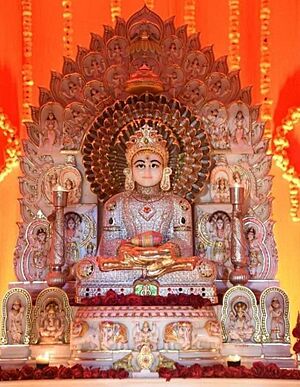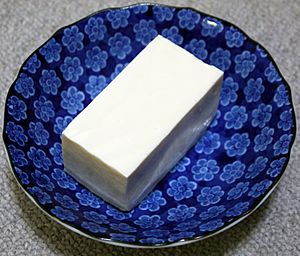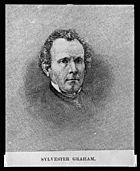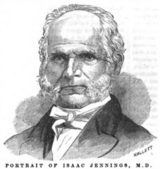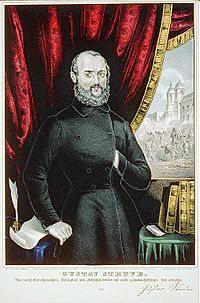History of vegetarianism facts for kids
Vegetarianism is a way of eating where people do not eat meat, poultry, or fish. The idea of not eating animals started a very long time ago. The earliest records come from ancient India, especially among Hindus and Jains. Later, some groups in Ancient Greece also chose to eat this way. In both places, this diet was linked to the idea of nonviolence towards animals. This idea is called ahimsa in India. Religious groups and thinkers often promoted it.
After the Christianization of the Roman Empire around the 4th to 6th centuries, vegetarianism almost disappeared in Europe. Some monks in medieval Europe avoided meat for religious reasons. However, they still ate fish. So, they were not vegetarians but pescetarians. Vegetarianism started to become popular again in Europe during the Renaissance. It became even more common in the 19th and 20th centuries. Today, about 0.5% to 4% of people in Western countries are vegetarian.
Contents
- Ancient History of Not Eating Meat
- Early Modern Period: A New Start
- 19th Century: Growing Movements
- 20th Century: Growing Popularity
- Vegetarianism Today
- See also
Ancient History of Not Eating Meat
India's Early Vegetarian Ways
Jainism and Buddhism: Old Rules
Ancient texts from the Jain and Buddhist religions show that being kind to animals was a key rule. This was true as early as the 6th century BCE. The Jain idea of nonviolence is very strict. It might even be older than Buddhism. Lord Parshvanath, a Jain leader, lived in the 9th century BCE. Historians believe he was a real person. He taught nonviolence just as strongly as it was practiced later by Mahavira's followers. The Tirukkural, written around the 5th century CE, talks about not harming animals. It also promotes a diet without animal products.
Not everyone who avoided killing animals also stopped eating meat. So, whether early Buddhists were vegetarian is debated. Some believe that the Buddha and his followers ate meat if it was offered to them. They would only refuse if they thought the animal was killed just for them. Others believe the Buddha and his monks were strict vegetarians. They think accepting meat later became allowed as rules became less strict.
Different ancient texts support both ideas. These texts were written centuries after the Buddha died. They might show different views within early Buddhism. The Vinaya Pitaka says the first split in Buddhism happened when the Buddha was alive. A group of monks wanted stricter rules, including a total ban on eating meat.
The Buddhist emperor Ashoka (304–232 BCE) was a vegetarian. He strongly promoted nonviolence towards animals. He made laws to protect many animal species. He also stopped animal sacrifices at his court. He told people to avoid all unnecessary killing and hurting.
Hinduism: A Deep Connection
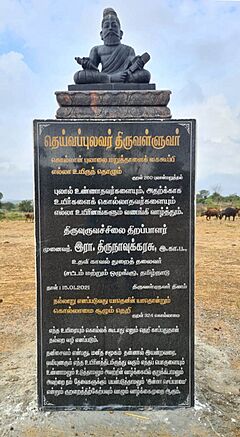
Many people believe Hinduism has the strongest link to a vegetarian lifestyle. In the ancient Vedic period (1500 to 500 BCE), eating some meats was allowed. However, vegetarianism was encouraged. Hindu sacred texts, like the Vedas, say that all living things share the same life force. Because of this, they deserve care and kindness. Many Hindu writings tell people not to eat meat. Others, like the Ramayana and Mahabharata, suggest a vegetarian diet. In Hinduism, killing a cow is traditionally seen as a sin.
Vegetarianism was, and still is, required for Hindu yogis. This includes followers of Hatha Yoga and Vaishnava schools of Bhakti Yoga. A devotee offers all food to Vishnu or Krishna as prasad before eating it. Only vegetarian food can be offered as prasad. Yogic thought says that saatvik food is pure and calms the mind. It helps the mind work its best and keeps the body healthy. Saatvik foods include grains, fresh fruits, vegetables, nuts, and milk from cows that live naturally. Many Vaishnava schools avoid vegetables like onion, garlic, and mushrooms. They believe these foods do not have saatvik effects.
Some thinkers suggest that vegetarianism in India grew from the idea of restoring balance. They say that as civilization grew, so did cruelty. Helpless humans and animals were exploited more. This disturbed nature's balance. Many tried to bring back kindness and balance. Living in harmony with nature became important for rulers.
Zoroastrianism: Some Followers Choose It
Some followers of Ilm-e-Kshnoom, a branch of Zoroastrianism in India, are vegetarian. There have been different religious writings supporting vegetarianism in Zoroastrian history. Some even claim that Zoroaster himself was vegetarian.
Mediterranean Basin: Ancient Ideas
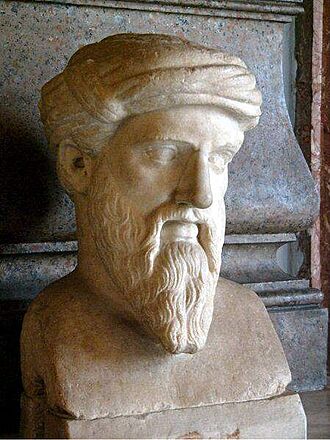
Ancient Greece: Philosophers and Diet
In Ancient Greece, a vegetarian diet was called abstinence from beings with a soul. This way of life was only followed by a small number of people. These were usually part of specific philosophical or religious groups. The earliest mentions of a vegetarian diet in Europe come from Homer and Herodotus. They talk about the Lotophagi (Lotus-eaters). These people lived on the North African coast and ate only lotus fruits. Other ancient stories also mention vegetarian groups.
The first clear evidence for vegetarian ideas in Greece is from the 6th century BCE. The Orphics, a religious group, may have been vegetarian. It is not clear if the Greek teacher Pythagoras truly promoted vegetarianism. He might have only forbidden certain kinds of meat. Later writers said Pythagoras banned all meat. Eudoxus of Cnidus, a student of Plato, wrote that Pythagoras was very pure. He avoided killing and even stayed away from cooks and hunters. Pythagoras believed animals had intelligence and feelings. Because of this, he thought it was wrong to mistreat them.
Pythagoras's followers, called Pythagoreans, did not always follow a strict vegetarian diet. But their closest group did. For most people, not eating meat was a sign of the "Pythagorean way of life." Both Orphics and strict Pythagoreans also avoided eggs. They did not take part in meat offerings to the gods. In the 5th century BCE, the philosopher Empedocles strongly supported vegetarianism and respect for animals. The Roman poet Ovid wrote about Pythagoras in his Metamorphoses. In this story, Pythagoras promotes strict vegetarianism. Because of this, people in early modern England called vegetarians "Pythagoreans."
People in ancient Greece debated whether humans had duties towards animals. The arguments were much like today's discussions on animal rights. Vegetarianism was often part of religious beliefs. These beliefs included the idea of transmigration of the soul, where souls could be reborn into animals. Many people, both vegetarians and non-vegetarians, believed that in a "Golden Age" at the start of humanity, people were completely non-violent. In this perfect world, hunting, farming animals, and eating meat were not needed. The earth provided all the food people needed naturally. This myth was written about by Hesiod, Plato, and Ovid. Ovid also praised Pythagoras's idea of universal nonviolence.
Most Stoic philosophers were against vegetarianism. They believed animals did not have reason. So, they thought there were no ethical duties towards animals. Followers of the Cynic school lived very simply. Their diet was almost meatless, but they did not make vegetarianism a main rule.
In the Platonic Academy, the leaders Xenocrates and Polemon supported vegetarianism. In the Peripatetic school, Theophrastus, who followed Aristotle, also supported it. Some important Platonists and Neo-Platonists in the Roman Empire were vegetarian. These included Apollonius of Tyana, Plotinus, and Porphyry. Porphyry wrote a detailed ancient text supporting vegetarianism. He believed animals were aware and could think. He argued that eating meat made the body unhealthy. Porphyry said that killing an animal was like taking a human life. He was one of the first to say that animal life was equal to human life.
Among the Manicheans, a religious group from the third century CE, there was an elite group called Electi. They were lacto-vegetarians for ethical reasons. They followed a strict rule against killing. Regular Manicheans, called Auditores, followed less strict rules of nonviolence.
Judaism: A Moral Ideal
Some Jewish scholars have said that the Torah supports vegetarianism. This could be for now or in a future time of peace. Some writers believe the Jewish prophet Isaiah was vegetarian. Some ancient Jewish groups did not eat meat, at least when Israel was in exile. Medieval scholars like Joseph Albo saw vegetarianism as a moral ideal. They worried about the moral character of someone who slaughtered animals.
East Asia: Long Traditions
China: Buddhist and Taoist Diets
The religions of Chinese Buddhism and Taoism require monks and nuns to eat a vegetarian diet without eggs or onions. Since monasteries often grew their own food, this usually meant they ate a vegan diet. Many religious groups also avoid harming plants by not eating root vegetables. This is not just a strict practice. Chinese spirituality often believes animals have immortal souls. They also think a diet mostly of grains is healthiest for humans.
In Chinese folk religions, and the faiths mentioned above, people often eat vegan on certain days. These include the 1st and 15th of the month, and Chinese New Year's Eve. Some non-religious people do this too. This is similar to the Christian practice of lent. The number of people who are always pure vegetarian is about the same as in the modern English-speaking world. This percentage has not changed much for a long time. Many people eat vegan for a period to make up for sins they believe they have committed.
Foods like seitan, tofu skin, and other meat alternatives came from China. They became popular because so many people avoided meat at times. In China, you can find eggless vegetarian versions of many foods, from seafood to ham. Also, the Thai and Vietnamese words for vegetarianism come from the Chinese term for a lenten diet.
Japan: Emperor's Ban
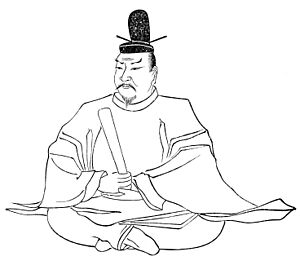
In 675, Emperor Tenmu banned the use of livestock and eating some wild animals in Japan. This included horses, cattle, dogs, monkeys, and birds. This happened because of the influence of Buddhism. Later, in 737, Emperor Seimu allowed eating fish and shellfish. For 1200 years, from the Nara period to the Meiji Restoration in the late 1800s, Japanese people mostly ate vegetarian meals. Their main food was rice, along with beans and vegetables. Fish was only served on special days. During this time, Japanese people, especially Buddhist monks, created a vegetarian cuisine called shōjin-ryōri. This cooking style is native to Japan.
In 1872, during the Meiji Restoration, Emperor Meiji lifted the ban on eating red meat. This was part of Japan opening up to Western influences.
Orthodox Christianity: Fasting Diets
In Eastern Orthodox Christianity (like in Greece, Russia, and Serbia), followers eat a diet completely free of animal products during fasting periods. This includes dairy and eggs, but honey is allowed. They also avoid oil and alcohol during strict fasts. The Ethiopian Orthodox Church has many fasting periods. During these times, they eat no animal products, including dairy and eggs. Because of this, Ethiopian cooking has many vegan dishes.
Christianity: Early and Medieval Times
Many early Christians were vegetarian. These included Clement of Alexandria, Origen, Jerome, and Basil the Great. Some early church writings suggest that Matthew, Peter, and James were vegetarian. The historian Eusebius wrote that the Apostle "Matthew ate seeds, nuts and vegetables, without flesh." The philosopher Porphyry wrote a whole book called On Abstinence from Animal Food. This book collected most of the ancient ideas on the topic.
In later ancient times and the Middle Ages, many monks and hermits stopped eating meat. This was part of their strict religious practices. St Jerome (died 419) was a famous example. The Rule of St Benedict (6th century) allowed Benedictine monks to eat fish and fowl. But it banned eating meat from four-legged animals, unless a monk was sick. Many other religious rules had similar food limits. Some even included fowl. But fish was never banned, as Jesus himself ate fish. These monks and nuns wanted to live simply and deny themselves pleasures. William of Malmesbury wrote that Bishop Wulfstan of Worcester (died 1095) became a strict vegetarian because he found it hard to resist the smell of roasted goose. Saint Genevieve, the patron saint of Paris, also ate a vegetarian diet. This was an act of self-control, not because she cared for animals.
Some historians say there is no clear evidence that ancient or medieval Christians were vegetarian for ethical reasons. They might have shown kindness to animals, but they did not openly object to killing them. Important theologians like St Augustine and St Thomas Aquinas said that humans do not owe duties to animals. Although St. Francis of Assisi spoke about animals in a spiritual way, sources do not say he was vegetarian.
Many ancient groups who disagreed with mainstream Christian views were vegetarian. These included the Encratites and the Ebionites. Medieval groups like the Bogomils and Cathars also disliked eating meat.
Early Modern Period: A New Start
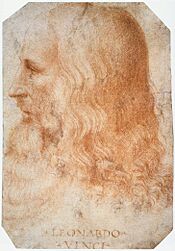
During the European Renaissance, vegetarianism began again in Europe. This time, it was based on the idea of animal rights. Famous people who supported it included Leonardo da Vinci (1452–1519) and Pierre Gassendi (1592–1655). In the 17th century, the English writer Thomas Tryon (1634–1703) was a key thinker about the meatless diet. Later, the Romantic poets also supported it.
However, important philosophers like René Descartes (1596–1650) and Immanuel Kant (1724–1804) believed humans had no ethical duties to animals. But Kant also said that "He who is cruel to animals becomes hard also in his dealings with men." By the end of the 18th century in England, the idea that animals were only for human use was still common. But it was starting to disappear.
In the United States, small groups of Christian vegetarians existed in the 18th century. One well-known group was the Ephrata Cloister in Pennsylvania. This religious community was founded in 1732. Benjamin Franklin became vegetarian at age 16. But he later started eating meat again, though he did not want to. He also brought tofu to America in 1770.
19th Century: Growing Movements
Vegetarianism was often linked to other reform movements. These included movements for temperance (avoiding alcohol) and against vivisection (animal testing). It was promoted as part of a "natural way of life." Some supporters criticized their society and wanted to improve public health.
Great Britain: The First Society
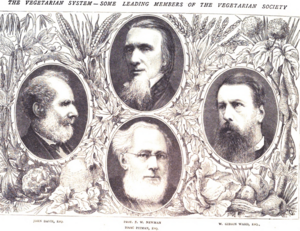
In the early 1800s, vegetarian ideas were more popular in England than anywhere else in Europe. English vegetarians were very keen to put their ideas into practice. Vegetarianism was strongest in northern and central England, especially in cities. As the movement grew, more working-class people became vegetarians. However, they were still a small number compared to meat-eaters. Groups were formed across England. But the movement did not gain widespread support. It was overshadowed by other, more exciting, struggles of the late 1800s.
In 1802, Joseph Ritson wrote a book called An Essay on Abstinence from Animal Food, as a Moral Duty. Reverend William Cowherd started the Bible Christian Church in 1809. He promoted vegetarianism as a form of temperance. His group was one of the early influences on the Vegetarian Society. Martha Brotherton wrote Vegetable Cookery in 1812. This was the first vegetarian cookbook.
The poet Percy Bysshe Shelley (1792–1822) was a strong supporter of ethical vegetarianism in the early 19th century. He was influenced by a book called Return to Nature, or, Defence of the Vegetable Regimen (1811). In 1813, he published his own essay, A Vindication of Natural Diet.
The first Vegetarian Society in the modern Western world was founded in England in 1847. It was started by 140 people at a conference in Ramsgate. By 1853, it had 889 members. By the end of the century, the group had nearly 4,000 members. After its first year, the group grew to 265 members, aged 14 to 76. English vegetarians were a small but very active group. Many believed in a simple life and "pure" food. They also held humanitarian ideals and strong moral principles.
The Cornishman newspaper reported in March 1880 that a vegetarian restaurant had been in Manchester for some years. Another had just opened in Oxford Street, London.
Social Class and Diet
Social class played a big role in the Victorian vegetarian movement. There was a gap between the upper-middle class and the working class. The upper-middle class tried to reach out to working-class people. But many working-class Britons ate mostly vegetarian diets out of need, not choice. They did not have the luxury of choosing what to eat. They believed a mixed diet gave them energy.
Women's Role in the Movement
Women were very visible in the vegetarian movement. They were often shown as symbols in journals, like healthy English women. Two important female vegetarians were Elizabeth Horsell and Jane Hurlstone. Elizabeth Horsell wrote a vegetarian cookbook and gave lectures. Jane Hurlstone was active in animal welfare and other causes. Even though men often got more attention, a newspaper noted that women did more work for vegetarianism and animal welfare. They cooked vegetarian meals for public dinners and organized events. Outside the home, Victorian women edited vegetarian journals, wrote articles, and wrote cookbooks. Of 26 vegetarian cookbooks from the Victorian Age, 14 were written by women.
In 1895, the Women's Vegetarian Union was started by Alexandrine Veigele. She was a French woman living in London. The group wanted to promote a 'purer and simpler' diet. They often reached out to the working class.
The moral arguments for vegetarianism brought together idealists from different causes. Many vegetarian women were also feminists. In her feminist utopia novel, Herland (1915), Charlotte Perkins Gilman imagined a vegetarian society. Margaret Fuller also supported vegetarianism in her book, Women of the Nineteenth Century (1845). She argued that when women were free from home duties, they would help change society. She believed vegetarianism would become the main diet. Frances Power Cobbe, a co-founder of a group against animal testing, was vegetarian. She was also a well-known feminist activist. Many of her colleagues in the first-wave feminist movement were also vegetarians.
United States: New Cookbooks and Societies
In 1835, Asenath Nicholson wrote the first American vegetarian cookbook. In 1845, the vegetarian newspaper The Pleasure Boat began publication.
In the United States, Reverend William Metcalfe (1788–1862) preached vegetarianism. He was a pacifist and a member of the Bible Christian Church. He and Sylvester Graham, who invented Graham crackers, helped found the American Vegetarian Society in 1850. In 1838, Dr. William Alcott published "Vegetable Diet: As Sanctioned by Medical Men, and by Experience in All Ages." This book was very important in American vegetarian writing.
Ellen G. White, one of the founders of the Seventh-day Adventist Church, became a supporter of vegetarianism. The Church has recommended a meatless diet ever since. Dr. John Harvey Kellogg (famous for corn flakes), a Seventh-Day Adventist, promoted vegetarianism. He did this at his Battle Creek Sanitarium as part of his "biologic living" theory.
American vegetarians like Isaac Jennings and Russell T. Trall were linked to the natural hygiene movement.
Other Countries: Famous Supporters
In Russia, Leo Tolstoy (1828–1910) was the most famous supporter of vegetarianism.
In Germany, the politician and revolutionist Gustav Struve (1805–1870) was a key figure in the early vegetarian movement. He was inspired by Rousseau's book Emile: or, On Education. Many vegetarian groups were founded in the late 1800s. The Order of the Golden Age became very well known. In 1886, a German couple, Elisabeth Förster-Nietzsche and Bernhard Förster, moved to Paraguay. They started a community called Nueva Germania to try out ideas about vegetarianism. However, the vegetarian part did not last long.
20th Century: Growing Popularity
The International Vegetarian Union, which connects national vegetarian societies, was founded in 1908. In Western countries, vegetarianism grew in the 20th century. This was due to concerns about nutrition, ethics, and later, the environment and economic issues. The Union's 1975 World Vegetarian Congress in Maine had a big impact on the vegetarian movement in the United States.
Henry Stephens Salt (1851–1939) and George Bernard Shaw (1856–1950) were famous vegetarian activists.
In 1910, doctor J. L. Buttner wrote a vegetarian book called A Fleshless Diet. He argued that meat was dangerous and not needed.
Cranks opened in London in 1961. It was the first successful vegetarian restaurant in the UK. Eventually, there were five Cranks restaurants in London, but they closed in 2001.
The Indian idea of nonviolence had a growing impact in the Western world. Mahatma Gandhi was a strong supporter of nonviolence towards animals. His example helped make vegetarianism more popular in Western countries. Studying Eastern religious ideas about nonviolence also helped shape Albert Schweitzer's idea of "reverence for life." This idea is still used today in discussions about ethical diets. But Schweitzer himself only became vegetarian shortly before he died.
Singer-songwriter Morrissey talked about vegetarianism in his song and album Meat is Murder. His fame helped make meat-free lifestyles more popular.
The 1932 book The Vegetarian and Fruitarian was published. It promoted ethics, health, and long life. At that time, the vegetarian and raw food movements were partly linked to feminism. It was seen as a way to free women from the kitchen. This would allow them to do other activities and follow their interests.
In August 1944, some members of the British Vegetarian Society asked for a section in their newsletter about non-dairy vegetarianism. When this was refused, Donald Watson started a new newsletter in November 1944. He called it The Vegan News.
Dorothy Morgan and Donald Watson, who started the Vegan Society, chose the word vegan. It came from "the first three and last two letters of 'vegetarian'." Watson said it marked "the beginning and end of vegetarian."
Vegetarianism Today

Today, Indian vegetarians are mostly lacto-vegetarians (they eat dairy but no meat). They are thought to make up over 70 percent of the world's vegetarians. In India, 20–42 percent of the population is vegetarian. Less than 30 percent eat meat regularly.
Surveys in the U.S. show that about 6% of adults never eat meat, poultry, or fish. This group includes vegans. About half of these (3% of the population) never eat meat, poultry, fish, dairy, or eggs (vegans). Similar surveys in the 1990s showed that only about one percent of people in the U.S. were vegetarian. Also, 2021 surveys show about 5% of U.S. kids aged 8-17 never eat meat, fish, or poultry. About 2% never eat meat, fish, poultry, dairy, or eggs.
In 2013, PS 244 in Queens, New York, became the first public school to have an all-vegetarian menu. The meals still meet the required protein standards set by the USDA.
In 2014, the Jain pilgrimage city of Palitana City in India became the world's first legally vegetarian city. It made it illegal to buy and sell meat, fish, and eggs. It also banned related jobs like fishing and keeping animals for food.
According to a 2018 survey, about 25 percent of evening meals eaten in the UK do not contain meat or fish.
See also
- History of veganism
- Vegetarianism and religion
- List of vegan media
- Nutrition in Classical Antiquity
- Timeline of cellular agriculture
- Timeline of animal welfare and rights


